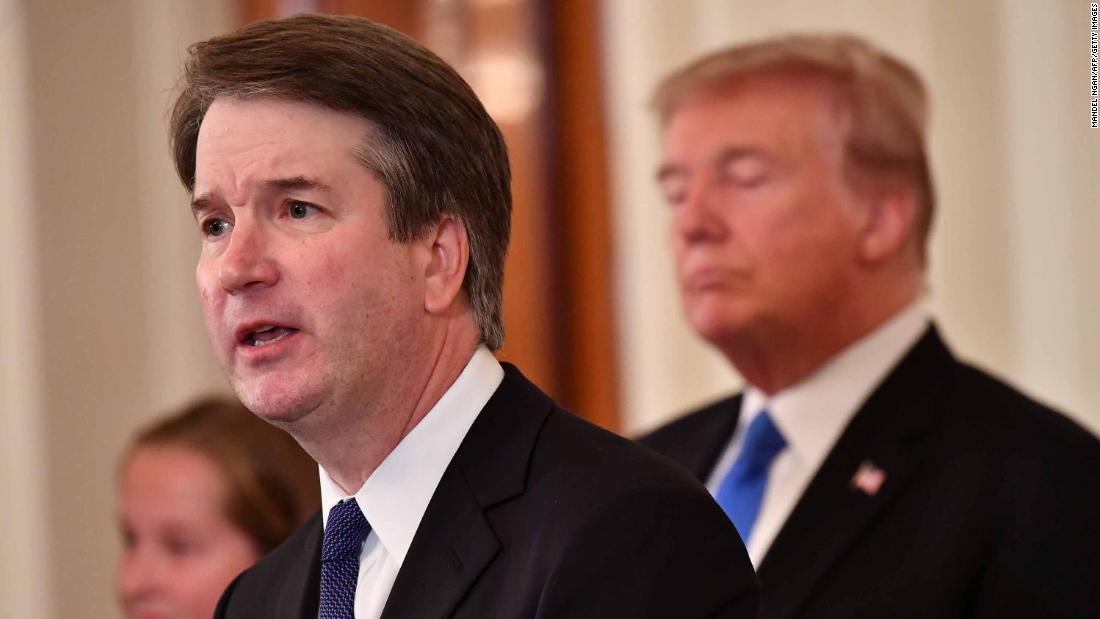
As the court rejected a Democratic attempt to allow mail-in votes, postmarked by Election Day, to be received up to six days after the election in Wisconsin, Kavanaugh also suggested that state courts may not have the last word in interpreting state election rules.
"Under the U.S. Constitution, the state courts do not have a blank check to rewrite state election laws for federal elections," Kavanaugh wrote in a footnote of his concurring opinion.
Kavanaugh's language overall mirrors President Donald Trump's rhetoric about calling a winner on election night.
States that require mail-in ballots to be returned by the Election Day, Kavanaugh wrote in his concurring opinion, "want to avoid the chaos and suspicions of impropriety that can ensue if thousands of absentee ballots flow in after Election Day and potentially flip the results of an election."
But those announcements are in no way official: They are projections made by national broadcast networks and wire services, based on how partial results compare to historical outcomes -- not by the states themselves, which typically take weeks before certifying elections.
Republican state legislatures in some states, including Pennsylvania, have blocked efforts to speed up the counting of mail-in ballots on election night. In Pennsylvania, the GOP-led legislature opposed changing policies to allow clerks to begin processing absentee ballots -- which have been cast by more Democrats than Republicans there -- before November 3. That means they'll have to open them and verify voters' eligibility on the day of the election, likely resulting in a slower-than-usual count that steadily builds in Democrats' favor.
Citing Bush v. Gore
Kavanaugh referenced Bush v. Gore, the court's opinion that decided the 2000 election along partisan and ideological lines and is still so controversial that it is rarely cited as precedent. He is one of three current justices -- along with John Roberts and Amy Coney Barrett -- who worked on Bush's side during the legal fight at the time.
Kavanaugh picked up on the reasoning of then-Chief Justice William Rehnquist in a concurrence that only garnered the votes of two other justices -- the late Justice Antonin Scalia and Justice Clarence Thomas.
"The text of Article II means that the 'clearly expressed intent of the legislature must prevail' and that a state court may not depart from the state election code enacted by the legislature," Kavanaugh wrote.
In the Wisconsin case Monday, Kavanaugh wrote to explain why he agreed with the court's 5-3 majority to block a federal district court's ruling that would have extended the deadline for the receipt of absentee ballots in Wisconsin amidst the pandemic.
Kavanaugh said he thought the district court changed the state's rules too close to an election and that courts should defer to state legislatures to address health concerns about Covid-19. He said he thought that Wisconsin's deadline is the same as that of several other states and is "reasonable given the all the circumstances."
But then he shifted to the role state courts should play. The court has yet to resolve how far can state courts go to change election rules put in place by state legislatures. The court deadlocked on that issue in a recent 4-4 split out of Pennsylvania without explanation.
CNN election law expert Rick Hasen said Kavanaugh's writing is a major clue.
"The conservatives on the court are going to look very skeptically at any state court rulings that might extend deadlines or change rules for recounts or other post-election activity," Hasen said.
He noted that the court had split 4-4 on that issue last week and that Barrett could make a difference. Barrett "could side with conservatives in these politically charged cases if she does not recuse herself from participating in them," he added.
Kavanaugh's concurrence came down just before Barrett appeared at the White House to be sworn in as Trump's third nominee. To many, her addition to the court will mark a rightward shift. Roberts, who since the retirement of Justice Anthony Kennedy has at times served as a swing vote, could well be outflanked by the new conservative wing. That could mean, to some, that Kavanaugh serves as the new swing vote at times.
"how" - Google News
October 27, 2020 at 10:26PM
https://ift.tt/37Pm3nB
Brett Kavanaugh foreshadows how Supreme Court could disrupt vote counting - CNN
"how" - Google News
https://ift.tt/2MfXd3I
https://ift.tt/3d8uZUG
Bagikan Berita Ini














0 Response to "Brett Kavanaugh foreshadows how Supreme Court could disrupt vote counting - CNN"
Post a Comment